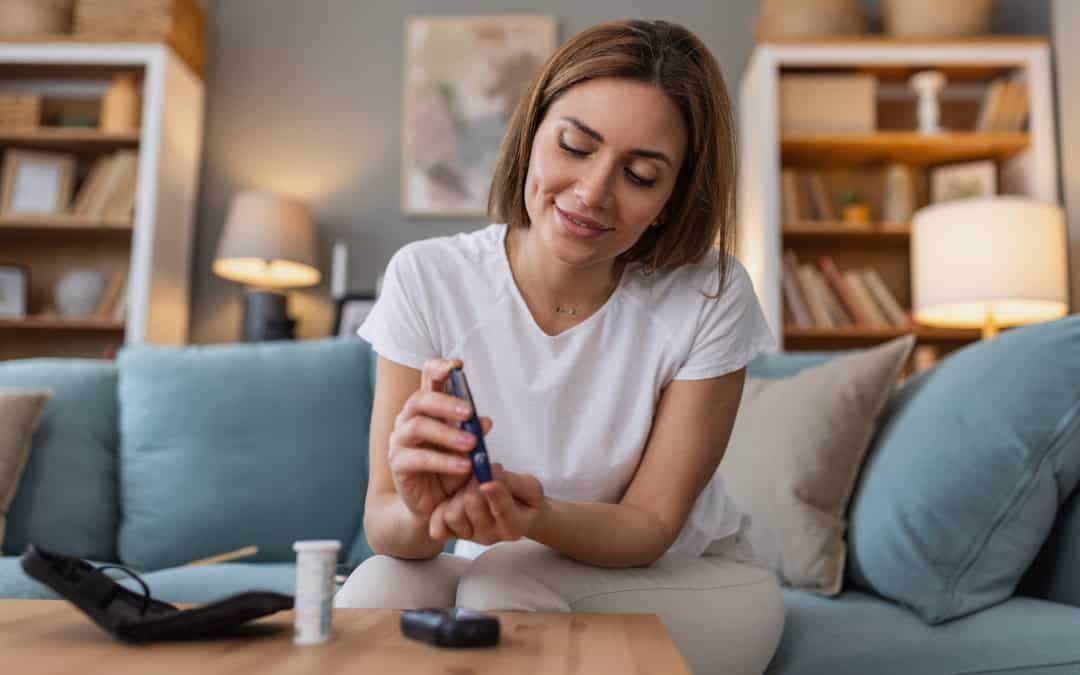Diabetic retinopathy affects more Americans than you might expect, ranking as the leading cause of vision loss in working-age adults between 25 and 74 years old. What makes this condition particularly troubling is that it progresses silently: damage occurs without noticeable symptoms until serious vision loss has already happened.
Even with these types of statistics, you still have significant power to protect your eyesight from diabetic retinopathy.
Two critical factors determine your risk more than anything else: how long you’ve had diabetes and how well you control your blood glucose levels. When you focus on managing these key areas, you can dramatically reduce your chances of developing this sight-threatening condition.
Whether you’ve recently been diagnosed with diabetes or have been managing it for years, this guide explains the daily habits that shield your vision, how to work effectively with your healthcare team, and the treatment options available if retinopathy does develop. You’ll discover practical strategies that can make the difference between maintaining clear sight and facing preventable vision loss.
Daily Habits That Help Prevent Diabetic Retinopathy
Blood glucose management serves as your strongest weapon against diabetic retinopathy.
Research demonstrates a direct relationship between blood glucose levels and both the development and worsening of diabetic retinopathy. When you reduce your HbA1c levels, you directly lower your risk of developing or progressing retinopathy.
Think of consistent blood sugar control as creating a protective environment for the delicate blood vessels in your retina. Each spike in glucose damages these tiny vessels a little more, while steady levels allow them to maintain their strength and function.
Movement matters more than you might think
Physical activity provides remarkable protection for your retinal health. Studies show that higher activity levels independently reduce your risk of diabetic retinopathy progression. Regular exercise delays the onset of eye complications, reduces inflammation throughout your body, and directly protects your retinal blood vessels.
However, it’s important to note that if you already have proliferative diabetic retinopathy, avoid high-intensity exercises that might strain your eyes.
What you eat affects what you see
Your food choices play a crucial role in protecting your vision. A low-glycemic index diet prevents diabetic complications because these foods cause slower, gentler rises in your blood sugar levels.
Include foods rich in omega-3 fatty acids in your meals. Recent research has shown that these nutrients help decrease your risk of sight-threatening diabetic retinopathy. Learn more about foods that help keep your eyes healthy in this article from the eye doctors at Chang Eye Group.
Other vision-protecting habits
Several additional lifestyle choices can significantly impact your eye health:
- Maintain a healthy weight – obesity increases your risk of non-proliferative diabetic retinopathy
- Prioritize quality sleep – poor sleep patterns predict a higher likelihood of vision-threatening complications
- Limit alcohol consumption – heavy drinking may worsen retinopathy progression
- Quit smoking immediately – tobacco use associates with early retinal damage
- Use continuous glucose monitoring – these devices help maintain steadier blood sugar and reduce the risk of diabetic retinopathy
These habits work together to create a strong foundation to protect your eyesight. While managing diabetes requires daily attention, these steps can make the difference between preserving your vision and facing preventable sight loss.
Working with Your Healthcare Team
Regular eye examinations can detect diabetic retinopathy before you notice any vision changes, making early intervention possible. Yet approximately 60% of Americans with diabetes don’t receive recommended eye exams. This gap in care represents millions of people at risk for preventable vision loss.
Don’t wait for symptoms to appear. The type of diabetes you have determines when you should schedule an eye exam. According to the American Academy of Ophthalmology (AAO), type 1 diabetes patients should schedule their first examination within 5 years of diagnosis, then annually afterward. If you have type 2 diabetes, schedule your first exam immediately upon diagnosis. Pregnant women with diabetes need an eye exam before conception or during the first trimester.
Understanding your eye care team
Your vision protection involves different specialists working together:
Optometrists provide routine eye care and monitor diabetes-related changes in your eyes. They can detect early signs of retinopathy and coordinate with your other healthcare providers.
Ophthalmologists are medical doctors specializing in eye diseases who can perform surgery if your condition advances.
Chang Eye Group serves the Pittsburgh area with the best eye care team of dedicated optometrists and experienced ophthalmologists.
What to discuss during your appointment
It is beneficial for you to come prepared with specific questions that will help you understand your risk. Here are some examples to help you get started:
- “How is diabetes currently affecting my vision?”
- “What blood sugar levels should I maintain to protect my eyes?”
- “Do I need more frequent monitoring based on my condition?”
Some patients may require exams every 2-4 months depending on their individual circumstances. Your eye doctor will determine the right schedule based on your diabetes control, duration of disease, and any retinal changes already present.
After each examination, request that your eye doctor share results with your primary diabetes care provider. This coordination ensures everyone managing your diabetes understands how well your current treatment plan protects your vision.
Schedule a comprehensive eye exam at Chang Eye Group in Pittsburgh where specialists use advanced diagnostic tools to detect diabetic retinopathy in its earliest stages, potentially saving your sight through timely intervention.
Advanced Prevention and Treatment Options
Sometimes diabetic retinopathy advances despite your best preventive efforts. When this happens, several proven treatments can halt progression and protect your remaining vision. Your eye doctor will recommend specific interventions based on how far the condition has progressed and which complications have developed.
Laser treatment: sealing and shrinking problem vessels
Laser photocoagulation remains a cornerstone treatment for diabetic retinopathy. During this procedure, your eye doctor uses precisely targeted laser beams to seal leaking blood vessels or shrink the abnormal ones that shouldn’t be there. Studies show laser treatment reduces severe vision loss risk by approximately 60%.
The procedure itself takes 20-40 minutes, though most patients need multiple treatment sessions. Your eye care team will first apply numbing drops to minimize discomfort during the procedure, and many people return to normal activities within a day or two.
Anti-VEGF injections: stopping abnormal blood vessel growth
These specialized medications target the specific proteins that cause problematic blood vessel growth in your retina. Your doctor injects anti-VEGF drugs—including ranibizumab (Lucentis), aflibercept (Eylea), and faricimab (Vabysmo)—directly into your eye to stop new vessel formation and reduce fluid buildup.
Clinical trials reveal that anti-VEGF treatment can match or even exceed the effectiveness of laser therapy for proliferative diabetic retinopathy. The injection process takes only a few minutes, though you may need treatments every few months depending on your response.
Vitrectomy surgery: addressing severe complications
When diabetic retinopathy causes significant bleeding or retinal detachment, vitrectomy surgery becomes necessary. This procedure removes blood from the vitreous gel inside your eye and repairs any retinal damage. About 39% of eyes undergoing vitrectomy develop retinal breaks during surgery, which is why careful evaluation and surgical expertise matter tremendously.
Remember that these treatments halt progression rather than cure diabetic retinopathy. Even after successful treatment, maintaining excellent blood glucose control remains essential for protecting your vision long-term. The earlier these interventions begin, the more vision can be preserved.
Protecting Your Vision from Diabetic Retinopathy
Diabetic retinopathy may develop silently, but you don’t have wait to get started with basic prevention steps. Throughout this guide, we’ve explored how this condition threatens vision before you notice any symptoms, yet the strategies to protect yourself remain within your control.
Blood glucose management stands as your most powerful defense. Daily habits that stabilize your blood sugar including regular physical activity and smart dietary choices help you create a foundation that protects your retinal health. When you add quality sleep, maintain a healthy weight, and avoid smoking, you’re building multiple layers of protection for your eyes.
Early detection makes the difference between preserving your sight and losing it.
Regular eye exams detect diabetic retinopathy before damage becomes irreversible. People with type 1 diabetes should schedule their first exam within five years of diagnosis, while those with type 2 diabetes need immediate screening. These appointments don’t just monitor your eyes but instead the visit to an experienced eye doctor can save your vision through timely intervention.
When prevention isn’t enough, treatment options like laser photocoagulation, anti-VEGF injections, and vitrectomy surgery can halt progression and preserve remaining sight. These interventions work most effectively when diabetic retinopathy is caught early, before extensive damage occurs.
The steps you take today determine your vision tomorrow. Don’t wait for symptoms to appear; unfortunately, symptoms will often signal that permanent damage has already happened. Schedule your diabetic eye exam at Chang Eye Group in Pittsburgh, where specialists can detect retinopathy in its earliest stages and help preserve your sight for years to come.
Call Chang Eye Group today to protect your vision through expert diabetic eye care.
FAQs
Q: How often should diabetics have their eyes examined?
A: For those with type 1 diabetes, schedule your first comprehensive eye exam within 5 years of diagnosis, then annually afterward. If you have type 2 diabetes, get your first exam immediately upon diagnosis. Pregnant women with diabetes should arrange an eye exam before conception or during the first trimester.
Q: What are the most effective daily habits to prevent diabetic retinopathy?
A: The most effective daily habits include monitoring blood sugar regularly, following a low-glycemic diet, staying physically active, maintaining a healthy weight, getting quality sleep, avoiding smoking and limiting alcohol consumption. Regular exercise and a balanced diet rich in omega-3 fatty acids are particularly beneficial.
Q: What treatment options are available for advanced diabetic retinopathy?
A: Advanced treatment options include laser photocoagulation to seal leaking blood vessels, anti-VEGF injections to stop new blood vessel growth, and vitrectomy surgery for severe cases involving vitreous hemorrhages or retinal detachment. The choice of treatment depends on the severity and specific complications of the condition.
Q: Can diabetic retinopathy be reversed?
A: While diabetic retinopathy cannot be reversed, its progression can be halted or slowed with proper management and treatment. Early detection through regular screenings is crucial, allowing for intervention before permanent vision damage occurs. Consistent blood glucose management remains the best strategy for prevention and control.
Q: What should I ask my eye doctor during a diabetic retinopathy screening?
A: Important questions to ask include: “How is diabetes affecting my vision?”, “What blood sugar levels should I maintain to protect my eyes?”, and “Do I need more frequent monitoring?” Also, request that your eye doctor share the examination results with your primary diabetes care provider to ensure coordinated care.






